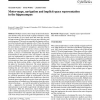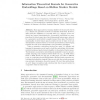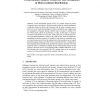226 search results - page 43 / 46 » Linear Bayesian Reinforcement Learning |
106
click to vote
COLT
1999
Springer
15 years 4 months ago
1999
Springer
We present a unified framework for reasoning about worst-case regret bounds for learning algorithms. This framework is based on the theory of duality of convex functions. It brin...
123
Voted
WSDM
2010
ACM
15 years 10 months ago
2010
ACM
Tagging plays an important role in many recent websites. Recommender systems can help to suggest a user the tags he might want to use for tagging a specific item. Factorization mo...
109
Voted
BC
2006
15 years 19 days ago
2006
Abstract Multiple sensory-motor maps located in the brainstem and the cortex are involved in spatial orientation. Guiding movements of eyes, head, neck and arms they provide an app...
129
click to vote
SSPR
2010
Springer
14 years 11 months ago
2010
Springer
Many approaches to learning classifiers for structured objects (e.g., shapes) use generative models in a Bayesian framework. However, state-of-the-art classifiers for vectorial d...
106
Voted
ICB
2009
Springer
15 years 7 months ago
2009
Springer
Linear discriminant analysis (LDA) is a popular method in pattern recognition and is equivalent to Bayesian method when the sample distributions of different classes are obey to t...



